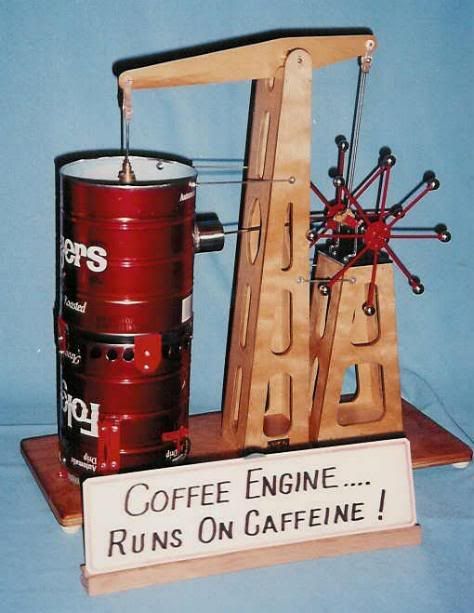Oldmechthings
Well-Known Member
- Joined
- Jan 10, 2008
- Messages
- 153
- Reaction score
- 12
Here is another Stirling Cycle engine put together of my own design. Perhaps a better name for it would have been a trash can engine, because that is where almost every part for it came from.
As you can see the stove and the water jacket are coffee cans. Out of sight is the displacer cylinder which is an empty one pound propane cylinder. The displacer is an aluminum pop can, the top packing gland was once a cutting torch tip. The power cylinder is part of an automotive shock absorber. The flywheels are nails with ball bearings attached to the heads. The crank bearings are out of some kind of office equipment. Even the wood was discarded scraps. About the only lathe machined part was the brass piston.

The sign or plaque was printed up as a gag for the first showing, but it has attracted so much attention, that it stayed with the engine. People are always coming up and telling me that they run on the same stuff. I had no idea that there were so many people that ran on caffeine. The government should launch a study. Perhaps caffeine is the answer to our energy problems.
Then there are those people who are plain stupid, and don't understand a joke, and think it actually runs on caffeine. With that kind I never pass an opportunity to give a detailed fictitious explanation of the reaction going on inside the engine. They go away feeling like they have really learned something and I have a good chuckle.
When I first built the engine I ran it on Sterno, which is quite expensive, and so often I'd open up a new can and it would all be evaporated. Then I learned I could stuff the can with fiber type insulation and soak it with denatured alcohol. With the can completely open it was too hot, but using a lid with about a 3/4" hole it was just right and worked beautiful.
Till next time
Birk
As you can see the stove and the water jacket are coffee cans. Out of sight is the displacer cylinder which is an empty one pound propane cylinder. The displacer is an aluminum pop can, the top packing gland was once a cutting torch tip. The power cylinder is part of an automotive shock absorber. The flywheels are nails with ball bearings attached to the heads. The crank bearings are out of some kind of office equipment. Even the wood was discarded scraps. About the only lathe machined part was the brass piston.

The sign or plaque was printed up as a gag for the first showing, but it has attracted so much attention, that it stayed with the engine. People are always coming up and telling me that they run on the same stuff. I had no idea that there were so many people that ran on caffeine. The government should launch a study. Perhaps caffeine is the answer to our energy problems.
Then there are those people who are plain stupid, and don't understand a joke, and think it actually runs on caffeine. With that kind I never pass an opportunity to give a detailed fictitious explanation of the reaction going on inside the engine. They go away feeling like they have really learned something and I have a good chuckle.
When I first built the engine I ran it on Sterno, which is quite expensive, and so often I'd open up a new can and it would all be evaporated. Then I learned I could stuff the can with fiber type insulation and soak it with denatured alcohol. With the can completely open it was too hot, but using a lid with about a 3/4" hole it was just right and worked beautiful.
Till next time
Birk
































































